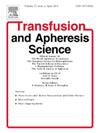The impact of leukapheresis and chemotherapy on early mortality in adult acute myeloid leukemia with hyperleukocytosis: Single center experience in Indonesia
IF 1.2
4区 医学
Q4 HEMATOLOGY
引用次数: 0
Abstract
Background
Hyperleukocytosis (HL) is associated with high rates of morbidity and early mortality of up to 29 % due to the development of leukostasis, tumor lysis syndrome (TLS), and disseminated intravascular coagulopathy (DIC) in adult acute myeloid leukemia (AML). The treatment options include chemotherapy, steroids, and leukapheresis. Leukapheresis has a beneficial effect on chemotherapy, but clinical trials showed controversy. We aimed to evaluate the effect of adding leukapheresis to chemotherapy on 30-day survival in AML patients with HL.
Methods
The study design was as a retrospective cohort study using secondary data from medical records collected between July and August 2024. Inclusion criteria were ages of 18 years and older, diagnosed with AML with a leukocyte count greater than 100,000/mm3 admitted to our hospital between January 2019 and July 2024, and received chemotherapy with and without leukapheresis. The primary endpoint is a 30-day survival rate since admission to the hospital. The Kaplan–Meier (log-rank) curve method was used for mortality between leukapheresis concomitant with chemotherapy (Group A) and chemotherapy only (Group B). Bivariate analysis is used to analyze correlations between mortality and clinical parameters.
Results
We identified 50 patients with 25 patients in each group. Group A showed a significantly higher leukocyte count (222 vs. 172.000/mm3 p = 0.031) and a larger proportion of leukostasis (80 % vs. 37.5 %, p = 0.002). The median overall survival in group A was 20 days (95 % confidence interval/CI: 17.178–22.822), while in group B 19 days (95 % CI: 8.394–29.606). By day 30, 72 % of patients in group A had died, compared to 84 % in group B. Kaplan-Meier analysis with log-rank test for 30 days of mortality showed an insignificant difference between the two groups with p log-rank: 0.352. In the bivariate analysis, age showed a significant negative correlation with the survival (r: −0.462, p = 0.001).
Conclusion
In our study, we showed a comparable 30-day survival of AML patients with HL receiving leukapheresis and chemotherapy and those treated with chemotherapy only. It indicated that leukapheresis reversed the poorer survival of group A to a similar level as group B. Older age was the only prognostic factor for unfavorable 30-day survival.
白细胞分离和化疗对成人急性髓性白血病伴白细胞增多症早期死亡率的影响:印度尼西亚的单中心经验
背景:成人急性髓性白血病(AML)中,由于白细胞淤积、肿瘤溶解综合征(TLS)和弥散性血管内凝血病(DIC)的发展,白细胞增多症(HL)与高达29% %的高发病率和早期死亡率相关。治疗方案包括化疗、类固醇和白细胞分离。白细胞摘除术对化疗有益,但临床试验存在争议。我们的目的是评估在化疗中加入白细胞分离对AML合并HL患者30天生存率的影响。方法采用回顾性队列研究,研究资料来源于2024年7月至8月收集的病历资料。纳入标准:年龄在18岁及以上,2019年1月至2024年7月在我院住院,诊断为AML,白细胞计数大于10万/mm3,接受化疗伴或不伴白细胞摘除术。主要终点是入院后的30天生存率。采用Kaplan-Meier (log-rank)曲线法比较白细胞摘除术合并化疗组(A组)和单纯化疗组(B组)的死亡率。双变量分析用于分析死亡率与临床参数之间的相关性。结果本组患者50例,每组25例。A组白细胞计数明显较高(222比172.000/mm3 p = 0.031),白细胞停滞比例较大(80 %比37.5% %,p = 0.002)。A组的中位总生存期为20天(95 %置信区间/CI: 17.178-22.822), B组为19天(95 % CI: 8.394-29.606)。到第30天,A组患者的死亡率为72 %,而b组为84 %。Kaplan-Meier分析和log-rank检验显示,30天死亡率在两组之间的差异不显著,p log-rank为0.352。在双变量分析中,年龄与生存率呈显著负相关(r: - 0.462, p = 0.001)。在我们的研究中,我们发现AML合并HL患者接受白血病切除和化疗与仅接受化疗的患者的30天生存率相当。结果表明,白细胞分离将A组较差的生存率逆转至与b组相似的水平。年龄较大是不利的30天生存率的唯一预后因素。
本文章由计算机程序翻译,如有差异,请以英文原文为准。
求助全文
约1分钟内获得全文
求助全文
来源期刊
CiteScore
3.60
自引率
5.30%
发文量
181
审稿时长
42 days
期刊介绍:
Transfusion and Apheresis Science brings comprehensive and up-to-date information to physicians and health care professionals involved in the rapidly changing fields of transfusion medicine, hemostasis and apheresis. The journal presents original articles relating to scientific and clinical studies in the areas of immunohematology, transfusion practice, bleeding and thrombotic disorders and both therapeutic and donor apheresis including hematopoietic stem cells. Topics covered include the collection and processing of blood, compatibility testing and guidelines for the use of blood products, as well as screening for and transmission of blood-borne diseases. All areas of apheresis - therapeutic and collection - are also addressed. We would like to specifically encourage allied health professionals in this area to submit manuscripts that relate to improved patient and donor care, technical aspects and educational issues.
Transfusion and Apheresis Science features a "Theme" section which includes, in each issue, a group of papers designed to review a specific topic of current importance in transfusion and hemostasis for the discussion of topical issues specific to apheresis and focuses on the operators'' viewpoint. Another section is "What''s Happening" which provides informal reporting of activities in the field. In addition, brief case reports and Letters to the Editor, as well as reviews of meetings and events of general interest, and a listing of recent patents make the journal a complete source of information for practitioners of transfusion, hemostasis and apheresis science. Immediate dissemination of important information is ensured by the commitment of Transfusion and Apheresis Science to rapid publication of both symposia and submitted papers.

 求助内容:
求助内容: 应助结果提醒方式:
应助结果提醒方式:


